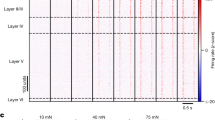Summary
The development of the sensitivity of embryonicXenopus skin to tactile stimulation has been re-examined. Two types of sensitivity were found. There is an overall sensitivity to stronger stimuli such as pokes, pinches or pin pricks from the time that the embryo first responds to stimulation. This sensitivity depends on the excitability of the skin rather than on precocious innervation. A second type of sensitivity appears a little later in development, over the myotomes near the neck. This sensitivity is to light touch, and gradually spreads to include most of the body surface by the time of hatching (Pig. 5). Evidence from the way this sensitivity develops and lesion experiments to the neural crest, suggest that the light touch sensitivity inXenopus depends on innervation of the skin by Rohon-Beard neurones of the spinal cord. The two types of sensitivity described help to resolve apparently conflicting results from previous studies.
Similar content being viewed by others
References
Abu Gideiri, Y. B.: The development of locomotory mechanisms inBufo regularis. Behaviour38, 121–132 (1971)
Coghill, G. E.: Correlated anatomical and physiological studies on the growth of the nervous system of Amphibia. I. The afferent system of the trunk ofAmblystoma. J. comp. Neurol.24, 161–233 (1914)
Coghill, G. E.: Correlated anatomical and physiological studies of the growth of the nervous system in Amphibia. III. The floor plate ofAmblystoma. J. comp. Neurol.37, 37–69 (1924)
DuShane, G. P.: Neural fold derivatives in the Amphibia: Pigment cells, spinal ganglia and Eohon-Beard cells. J. exp. Zool.78, 485–503 (1938)
Hooker, D.: The development and function of voluntary and cardiac muscle in embryos without nerves. J. exp. Zool.11, 159–186 (1911)
Hughes, A. P. W.: The development of the primary sensory system inXenopus laevis (Daudin). J. Anat. (Lond.)91, 323–338 (1957)
Nieuwkoop, P. D., Faber, J.: Normal tables ofXenopus laevis (Daudin). Amsterdam: North Holland Publ. Co. 1956
Roberts, A.: Conducted impulses in the skin of young tadpoles. Nature (Lond.)222, 1265–1266 (1969)
Roberts, A.: The role of propagated impulses in the sensory system of young tadpoles. Z. vergl. Physiol.75, 388–401 (1971)
Roberts, A., Stirling, C. A.: The properties and propagation of a cardiac-like impulse in the skin of young tadpoles. Z. vergl. Physiol.71, 295–310 (1971)
Wintrebert, P.: Sur l'existence d'une irritabilité exoito-motrice primitive indépendante de voies nerveuses chez les embryons ciliéas des batraciens. C.R. Soc. Biol. (Paris)57, 645–647 (1904)
Wintrebert, P.: La conduction aneurale de l'ectoderme chez les embryons d'Amphibiens. C.R. Acad. Sci. (Paris)171, 680–682 (1920)
Author information
Authors and Affiliations
Additional information
This work was partly supported by grant G970/286/B from the Medical Research Council.
Rights and permissions
About this article
Cite this article
Roberts, A., Smyth, D. The development of a dual touch sensory system in embryos of the amphibianXenopus laevis . J. Comp. Physiol. 88, 31–42 (1974). https://doi.org/10.1007/BF00695921
Received:
Issue Date:
DOI: https://doi.org/10.1007/BF00695921




